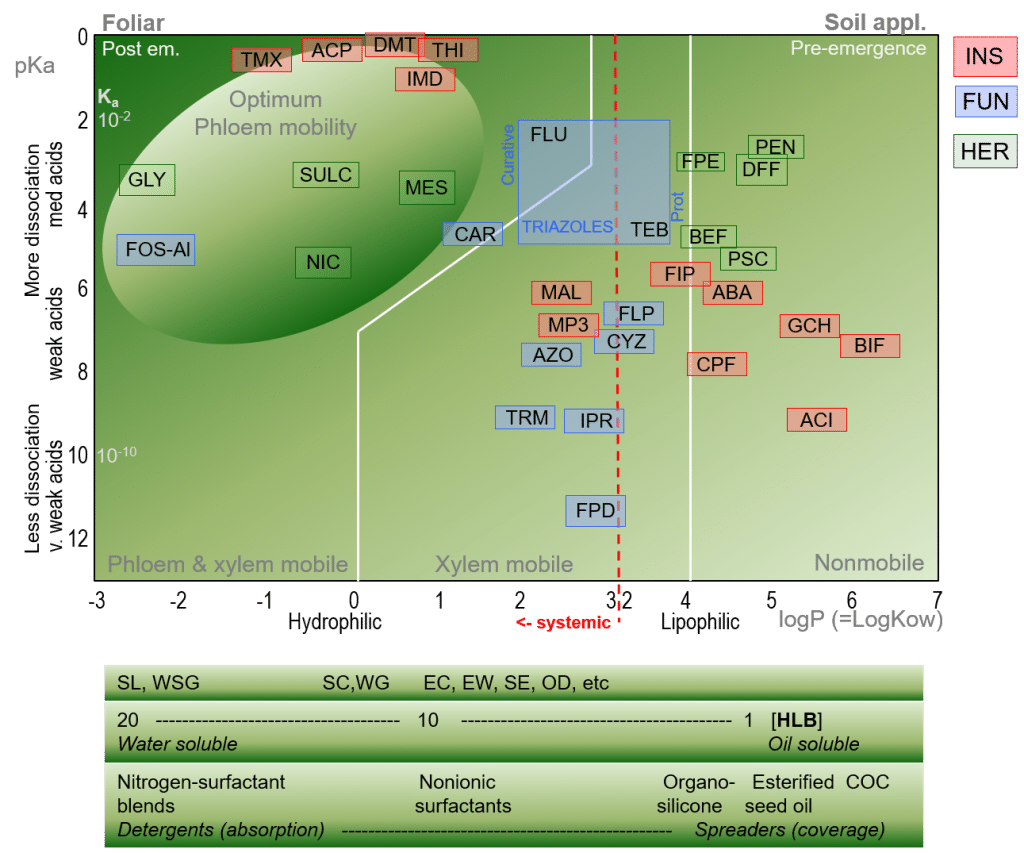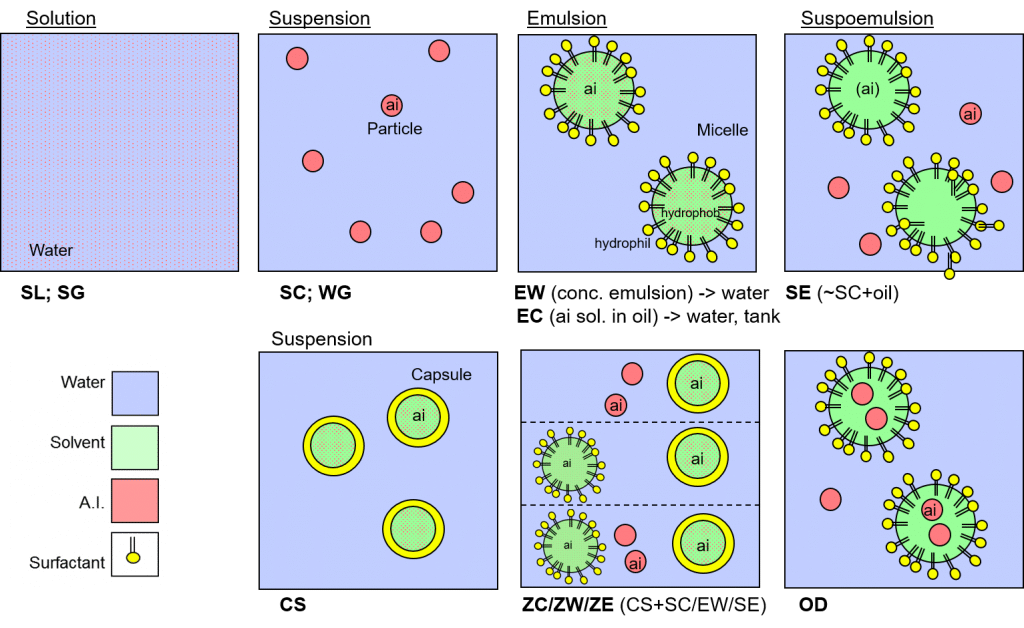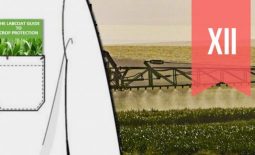The LabCoat Guide to Pesticide Mode of Action: Pesticide Solubility and Formulation
In this seventh article in the LabCoat Guide to Pesticide Mode of Action, I discuss Pesticide Solubility and Formulations.
A little about my background
I am a plant scientist with a background in Molecular Plant Biology and Crop Protection. 20 years ago, I worked at Copenhagen University on photosynthetic responses to stress in crops. Subsequently, I worked in Australia on molecular defense mechanisms induced by Phylloxera attack in grapevine.
At that time, biology-based crop protection strategies had not taken off commercially, so I transitioned to conventional (chemical) crop protection R&D at Cheminova, later FMC.
During this period, public opinion, as well as increasing regulatory requirements, gradually closed the door of opportunity for conventional crop protection strategies, while the biological crop protection technology I had contributed to earlier began to reach commercial viability.
From January 2018, I will consolidate 17+ years of industry experience in BioScience R&D management with my academic research background, to provide independent Strategic R&D Management as well as Scientific Development and Regulatory support to AgChem & BioScience organizations developing science-based products.
For more information, visit BIOSCIENCE SOLUTIONS – Strategic R&D Management Consultancy.
***
LogP, pKa and Solubility
In the previous article in this series, the partition coefficient (logP) and dissociation constant (pKa) of a pesticide active ingredient were shown to be determinants of pesticide mobility in plants.
The logP of a given molecule describes its lipophilicity or hydrophilicity, where lipophilicity describes a molecule’s ability to dissolve in lipophilic (non-aqueous) solutions, allowing permeation through biological membranes.
The pKa value of a given molecule defines the pH at which it is neutral. At greater pH values, acid groups will be charged, while at lower pH values base groups will be charged. The number and distribution of charges on a molecule affect its aqueous solubility.
It was concluded that the solubility of the active ingredient is thus determined by its lipophilicity and dissociation constant, and an understanding of these physicochemical properties is a vital component of pesticide formulation development.
Lipophilic active ingredient molecules may resist solubility in water – the most common medium for agricultural sprays – and typically require formulation with organic solvents or oils.
In contrast, hydrophilic active ingredient molecules are easily solubilized in aqueous spray solutions, while the uptake of these molecules across lipophilic plant leaf barriers often requires the inclusion of surfactants in the final product. Delay or insufficient uptake of the active ingredient may lead to reduced efficacy, wash-off of the active ingredient by rain or UV-degradation of the unprotected molecules.
Solubility and pesticide mobility within plants
As described in the previous article, pesticide active ingredient molecules may be positioned within the Bromilow model on the basis of their logP and pKa values. From this, predictions may be made of their mobility in plants.
The Bromilow model may be adapted by including formulation parameters, expanding the applicability of the model to permit formulation predictions on the basis of the solubility of the active ingredients.

Figure 1. Expanded Bromilow model for the prediction of pesticide mobility in plants and associated formulation predictions.
Surfactants
The expanded Brownlow model can be used to predict appropriate surfactants for specific active ingredients. Surfactants lower the surface tension of water, and permit the mixing of phases which would otherwise be immiscible. Surfactants include detergents, wetting agents, emulsifiers and antifoaming agents.
The hydrophilic-lipophilic balance (HLB) of surfactants is a measure of their hydrophilicity or lipophilicity. Hydrophilic surfactants (HLB>10) include oil-in-water emulsifying agents, detergents and solubilizing agents, while water-dispersible surfactants (HLB 6-10) include oil-in-water emulsifiers as well as wetting and spreading agents. Lipophilic surfactants include antifoaming agents and water-in-oil emulsifiers.
Surfactants may be toxic to humans and the environment. Polyethoxylated Tallow Amines (POEA) are non-ionic surfactants used as emulsifiers and wetting agents for pesticides, including herbicides such as glyphosate, and are toxic to aquatic species like fish and amphibians. Alternative surfactants are thus used for formulations designed for aquatic use.
Using the expanded Bromilow model, it is possible to predict formulation parameters for specific active substances ingredients on the basis of their solubility. Accordingly, water-soluble active ingredients will tend to be formulated as soluble liquid (SL) or water-soluble granular (WSG) formulations.
Less water-soluble active ingredients may be formulated as suspensions (suspension concentrates, SC), or may be solubilized in solvent micelles e.g. emulsions (EW or EC), suspo-emulsions (SE), microcapsule formulations (CS) or combinations of these (OD; ZC/ZW/ZE). Furthermore, suitable surfactant (ionic or non-ionic) or adjuvant candidates may be predicted on the basis of the active ingredients solubility.
Formulation types
The biological activity or mode of action of a pesticide is determined by its active ingredient, which is defined as the ingredient in a pesticide that is biologically active. The active ingredient in its raw form is called technical material and requires formulation to facilitate its handling, storage and application. A pesticide formulation is the commercial product as it is sold to farmers, and contains the requisite adjuvants, surfactants, solvents, stabilisers and conserving agents.
Dry formulations
Active ingredients may be formulated as so-called dry formulations. These formulations are relatively primitive in that the inclusion of e.g. surfactants is limited, and it is thus difficult to optimise their biological effect. On the other hand, dry formulations may be relatively cheap, stable and light, and are convenient for transport to isolated areas – where they may have to be carried manually – as well as storage under suboptimal conditions. These formulations may include
These formulations may include dusts (DP), wettable powders (WP), granules (GR), tablets (T) and water-dispersible granule (WDG). Pesticide dusts and wettable powders have the advantage of not containing organic solvents but have the disadvantage of low operator safety – an issue which may be addressed by formulating the active ingredients as granules, thereby reducing dust formation and intake while preparing the pesticides for application.
Granules have the advantage of being relatively cheap and are easily packageable, but they are generally only used in or on the soil and may require special equipment for their application.
Water-dispersible granules are easily handled (and required minimum packaging) as very little dust is produced, however, they require complicated manufacturing procedures (expensive) and their use may lead to nozzle blockage – in similarity with dusts, wettable powders and other granules.
Tablets are a convenient form of application, required minimum packaging and permit precise dosing, but are expensive and generally only viable for highly-active active ingredients.
Liquid formulations
Liquid formulations are the most frequently used pesticide products, and permit extensive formulation development through the inclusion of optimised solvents and surfactants, allowing for the optimisation of biological activity on the basis of an understanding of plant, pathogen and pest biology. Liquid formulations may be classified on the basis of the aqueous or non-aqueous solubility of their constituent active ingredients.
Accordingly, soluble liquid (SL) formulations typically contain water-soluble active ingredients, e.g. Glyphosate, and these products are easy to produce and are stable (precipitates are generally not formed).
Less soluble, more lipophilic active ingredients may be formulated as emulsions (EW/EC/SE formulations) which are highly efficacious but have the disadvantage of containing toxic organic solvents (EC), although EW and SE formulations have been developed with low to minimal solvent contents. Reducing the solvent content of emulsion formulations requires complex manufacturing procedures, and this affects the price of the final product.
Alternatively, less soluble active ingredients may be suspended (rather than solubilised) in suspension concentrate (SC) formulations, which have the advantage of not containing solvents (thereby reducing their toxicity) while having the disadvantage of poor storage stability (precipitation of the active ingredient). Microcapsule formulations (CS) require complex manufacturing procedures but permit the solubilisation of lipophilic active ingredients in a minimum of solvent, and the protective capsules promote long-term efficacy, as well as reduced toxicity.
Formulations in aqueous spray solutions.
For the end user, it is useful to understand how pesticide formulations react in aqueous spray solutions during and immediately following spray applications i.e within the spray tank, or on the surface of leaves.

Figure 2: Summary of formulation types in aqueous spray solutions.
In aqueous spray solutions, water-soluble active ingredients formulated as soluble liquid or soluble granule (SL; SG) formulations may be solubilised directly, but may require the addition of a spreader. Active ingredients formulated as suspension concentrates (SC) or water-dispersible granules (WDG; WG) will be dispersed as particles in suspension, and will require the addition of dispersing agents and thickeners to prevent their precipitation. Particular attention must be paid to the storage of these formulations, and they may require vigorous shaking prior to use, as well as agitation (stirring) in the spray tank.
For emulsion concentrate (EW) and emulsifiable concentrate (EC) formulations, the lipophilic active ingredients are solubilised in oil. When mixed in aqueous spray solutions, an emulsion is created as the oil (and emulsifiers) create micelles containing the solubilized active ingredient. In micelles, the lipophilic tails of the surfactant molecules favour the oil or solvent phase, while the polar hydrophobic “heads” of the surfactant molecules favour the water phase.
In contrast, in EW formulations the active ingredient is already dissolved in micelles (a concentrated emulsion) and is subsequently diluted in the spray tank. When emulsion spray droplets dry on the leaf surface, oil droplets remain and may act as adjuvants to facilitate the uptake of lipophilic active ingredients into the lipophilic plant leaf barriers (wax layers and cuticle). As these formulations may contain organic solvents, care must be taken to reduce operator exposure. EC formulations, in particular, may require stirring during application. While EC formulations are one of the most used formulation types, EW formulations offer a safer and less environmentally-challenging delivery system.
SC formulations generally have a lower activity than EC formulations, but may be preferred when a.i.-dependent phytotoxicity may pose a problem. If a mix of SC and EC formulations gives surprisingly good results, for example in a research trial, be aware that solvents and emulsifiers from the EC component may increase the uptake of the SC-formulated active ingredient.
Suspo-emulsions (SE) provide a combination of suspended particles (SC) and active ingredients solubilised in micelles (EW/EC), and also require shaking before use. Microcapsules (CS) enclose the solvent-solubilised active ingredient, and may also be subject to precipitation. Due to the encapsulation of the organic solvents, operator exposure hazards are minimised.
Of particular relevance for BioPesticides, yeast-derived microcapsules (YC) are under development as biological delivery systems. An added benefit of this type of formulation is that plants may recognise the yeast cells as possible invasive pathogens, leading to the induction of plant defence responses.
Recent formulation types include microcapsule / suspension combinations such as ZC (CS+SC), as well as microcapsule / emulsion (ZW:CS+EW) and microcapsule / emulsion / suspension (ZE: CS+SE) combinations. Shaking prior to spraying as well as avoidance of operator exposure may be required for these formulations.
Oil dispersions (OD) consist of active ingredients particles suspended in oil within micelles and are especially suited for water-sensitive active ingredients, such as sulfonylureas. The oil phase can have the advantage of acting as an adjuvant to facilitate uptake of the active ingredient into the plant. Attention should be paid to the risk of precipitation (sedimentation) of these formulations – cold storage at low temperatures should be avoided, and the formulations should be shaken before use.
Adjuvants
Adjuvants may be added to pesticide spray solutions to increase their biological efficacy, by increasing the retention of spray droplets and reducing their surface tension, by eliminating crystallisation of the active ingredients and by promoting their uptake across plant leaf barriers (waxy layers and cuticles). Adjuvants may include wetters and spreaders, stickers and penetrants, emulsifiers and oils as well as stabilising agents such as UV filters.
***
Thanks for reading – please help make the BioScience Blog great by liking or sharing this article, making it visible to your network!
Harry Teicher is the founder of BIOSCIENCE SOLUTIONS and an Authorpreneur, providing organizations with Strategic- and Project Management as well as Development & Communication solutions. Follow him on Linkedin, Twitter and Facebook.



